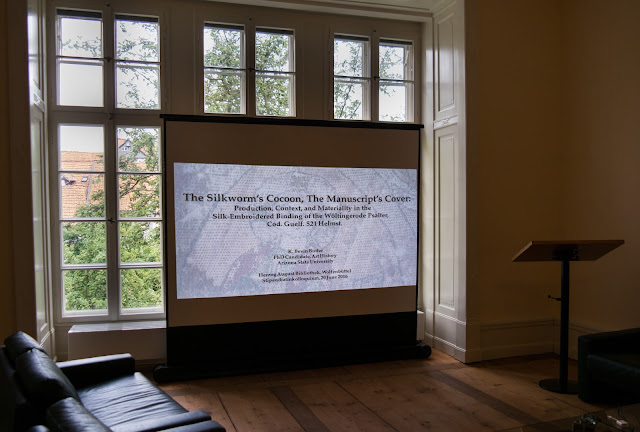Every two weeks here at the library, one of the fellows presents about their research at the "Stipendiatenkolloquium" (fellows colloquium) and Monday June 20 was my turn! I had worked very hard to prepare the paper and presentation, and was excited to present to a group of experts about a manuscript that lives right here at the HAB in Wolfenbüttel!
Here is just the "quick and dirty" of my talk: The main topic of my presentation was the embroidered cover of a thirteenth-century manuscript that was originally held at the monastic library at Kloster Wöltingerode.
 |
Front Cover: Christ in Majesty surrounded by Four Evangelists
(Matthew/Man, John/Eagle, Luke/Ox, Mark/Lion) |
 |
| Back Cover: Enthroned Virgin with Christ surrounded by Four Saints |
I began the project hoping to discover that the cover was embroidered and the book was bound within the monastery by the nuns themselves... But what I found was that I believe neither of those things to be true anymore! The basic points are as follows: there is no evidence that Wöltingerode had an embroidery workshop, and even though there was a binding workshop there, none of the bindings made in Wöltingerode are anything like this one.
 |
Wöltingerode
Bindings: Cod. Guelf. 1399, 1427, 1321, 1432, and 1144
Helmst. Wolfenbüttel: HAB.
|
I carefully analyzed the types of stitches and materials used to make the Wöltingerode cover-- silk embroidery on a linen cloth, using mostly gobelin stitch with some areas of a type of kloster stitch.
 |
| Gobelin Stitch |
 |
| Gobelin Stitch |
 |
| Klosterstich |
 |
| Klosterstich |
While searching for other similar embroideries or book covers, I stumbled upon a very famous manuscript in Goslar from another monastery there called Kloster Neuwerk. It is relevant to note that Neuwerk and Wöltingerode are only 10,7 km (6.5 miles) apart. The back cover of the Goslar manuscript is silk embroidery, very similar to the one now in Wolfenbüttel. I had only seen black & white images of the back cover published twice, even though the front cover and the illuminations inside the manuscript are extremely well-known. I figured it was a long-shot, but I decided to email the museum in Goslar to see if I could come look at the back cover and take photographs for my research project-- To my shock and delight, they were very happy to accommodate my request!! So I hopped on a train and headed to Goslar, which is only about 45 minutes from Wolfenbüttel on the train.
So here is the world premier of color photographs of the back cover of the Goslar Gospel!
 |
| Goslar Gospel, Back Cover: Coronation of the Virgin |
 |
| Goslar Gospel, Clasps and Spine |
Note that the gobelin stitches and the silk embroidery threads are remarkably similar:
 |
| Left: Goslar Gospel Gobelin Stitches & Right: Wöltingerode Psalter Gobelin Stitches |
 |
| Left: Goslar Gospel Jesus & Right: Wöltingerode Psalter Jesus |
|
After careful examination, I believe the two covers were produced in the same workshop. Unfortunately, I can't say exactly where... My best guess, for two main reasons, is that they were made somewhere near Hildesheim. First, both Kloster Wöltingerode and Kloster Neuwerk were within the Diocese of Hildesheim during the Middle Ages. Second, the use of gobelin stitch to cover the entire background of the cloth is a characteristic not as commonly found outside of the areas in and around Hildesheim.
Other than working to locate the embroideries, I explored some of the symbolic connotations of silk during and since the Middle Ages.
 |
| This is a quote from Saint Birgitta of Sweden's Revelations in which Christ speaks to Birgitta. |
Silkworms as virgins (Isidore of Seville wrote that worms were born "without sex") and silk as a pure by-product of pious labor are common tropes during the Middle Ages, and these connotations are especially significant when you consider the fact that the material was used to cover the most precious objects of the Church-- relics, reliquaries, altars, and manuscripts containing the Word of God.
Some of the questions during the Q&A after my talk were very challenging, but this is a great group of scholars for the exchange of ideas and I was encouraged that so many had questions and comments! I received positive feedback that evening and in the following days, so I am pleased to report that I feel the presentation was a success!!!















No comments:
Post a Comment